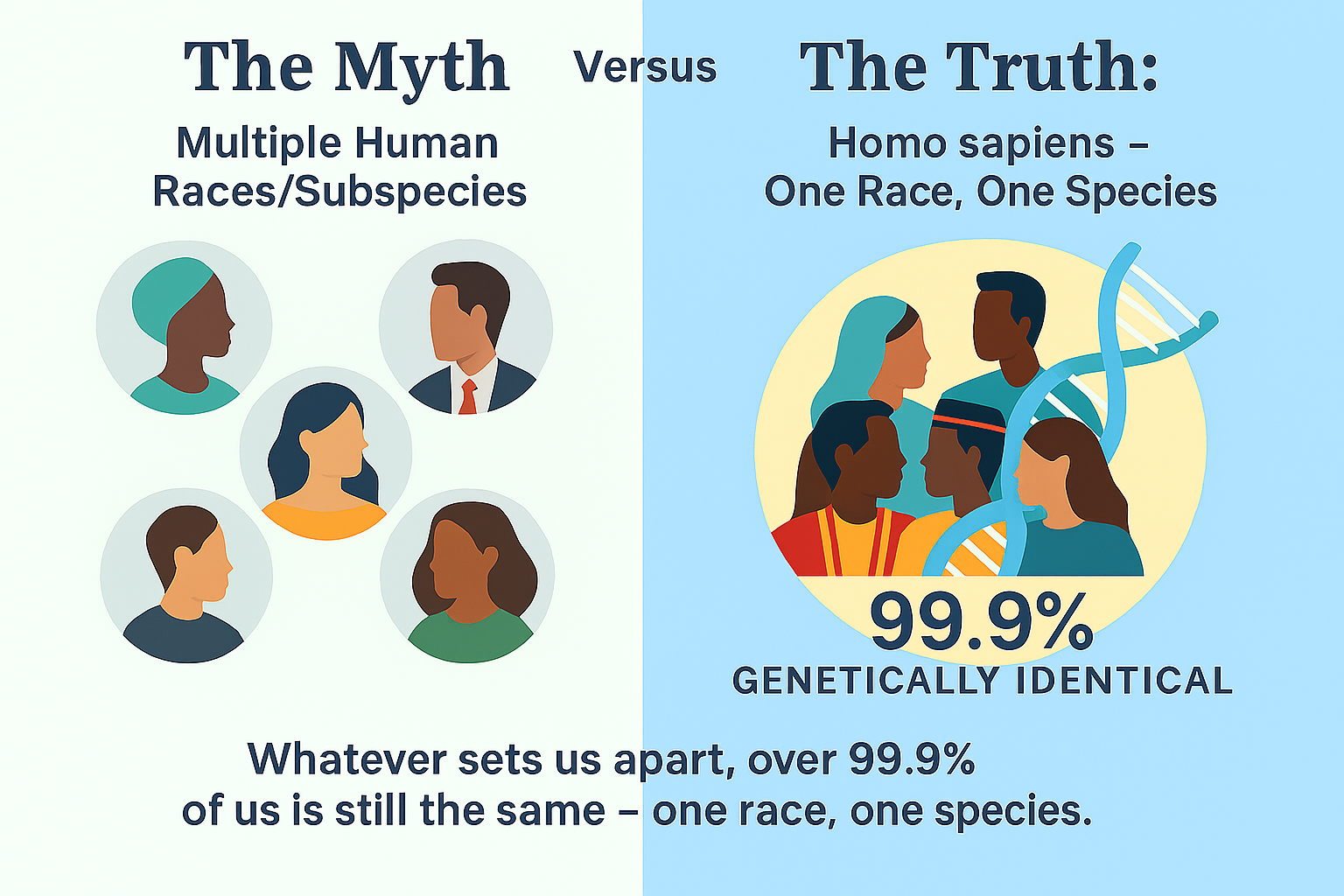Setting the stage
The statement “humans share over 99.9% of our DNA” is not a metaphor. It is a measurable result from whole‑genome studies: when you compare any two people, the sequence of ~3 billion DNA “letters” is nearly identical. The small fraction that differs does not create biological subspecies — and it does not align with social categories like race, nationality, or class.
The genetic evidence
How similarity is measured
Large‑scale sequencing projects compare genomes letter by letter. Variation is tracked at positions called SNPs (single‑nucleotide polymorphisms) and other small differences. Across the whole genome, the average difference between two unrelated people is about 1 in 1,000 letters — hence “99.9% the same.”
What lives in the 0.1%
- Traits: eye color, hair texture, skin tone, lactose tolerance, and other adaptations.
- Health: rare variants that influence disease risk or drug response.
- Identity: small, scattered differences that do not form coherent biological “races.”
Analogy
If your genome were a 1,000‑page book, fewer than one page would differ between you and a random stranger — and most of those edits are minor punctuation or spelling changes, not new chapters.
Key takeaways
- High overlap: humans are genetically very similar compared to many other species.
- Continuous variation: differences vary gradually across geography rather than in sharp blocks.
- No subspecies: there is no scientific basis for biological “races” within humans.
Why race isn’t biological
Population genetics consistently shows more genetic variation within any socially defined “race” than between such groups. The traits people notice (like skin tone) reflect a tiny set of genes shaped by local environments, not separate lineages.
Line‑drawing attempts to create biological races fail because human genetic variation is clinal (gradual) and overlapping. You cannot partition humanity into discrete, non‑overlapping genetic boxes.
Race as a Social Construct
Race isn’t written in our DNA — but it’s written into our societies. These categories were shaped by history, not biology, and used to justify inequality, exclusion, and division.
By understanding race as a social construct, we can begin to dismantle inherited hierarchies and affirm our shared humanity.
Migration and mixing
Our species has always moved. From early migrations out of Africa to trade, conflict, and modern mobility, populations have continually met, mixed, and shared genes. This long history of connection reinforces our genetic unity.
Local differences exist — that’s part of our diversity — but repeated mixing over tens of thousands of years keeps the whole population knit together as one species.
Genetic Strands of Truth
Our new understanding — that each of us is part of the same extended family — doesn’t alter our understanding of safe procreation. But it could profoundly transform how we treat each other: as individuals, as communities, and as a species.
Learn more about how genetic science rewrites the concept of race — affirming that we are all members of the same extended family.
Common misconceptions
-
“People from different continents are genetically very different.”
Most variation is shared globally; the average difference between any two humans remains small. -
“Race maps onto genetics cleanly.”
Social race categories are recent and culturally variable; genetic patterns are continuous and overlapping. -
“Ability differences imply separate kinds of humans.”
Differences in health, physical or intellectual ability, or talent do not constitute biological subspecies. -
“Ancestry tests prove biological races.”
These tests estimate probabilities of shared ancestry with reference groups; they don’t define discrete racial biology.
Why this matters
- Dignity: equal biological standing undercuts narratives of hierarchy and dehumanization.
- Policy: fair systems are easier to justify when we recognize one human family.
- Education: teaching the science reduces bias and inoculates against pseudoscience.
- Solidarity: shared problems (climate, health, security) demand shared solutions.
From fact to culture
Science alone doesn’t change hearts. It prepares the ground. Culture, stories, and daily practices help the truth take root.
Quick facts
99.9% shared DNA
On average, only about 0.1% of our genome differs between any two people — a tiny fraction of ~3 billion letters.
More within than between
Genetic variation is greater within any social group than between groups labeled as “races.”
No subspecies
Humans are one interbreeding population with continuous, overlapping variation — not separate biological races.
Migration knits us
Ancient and modern migrations continually remix genes, reinforcing our unity over time.
Keep exploring
Follow the threads that connect the science to our shared future.
